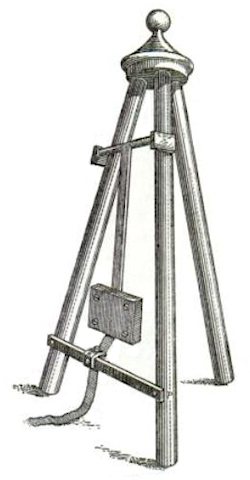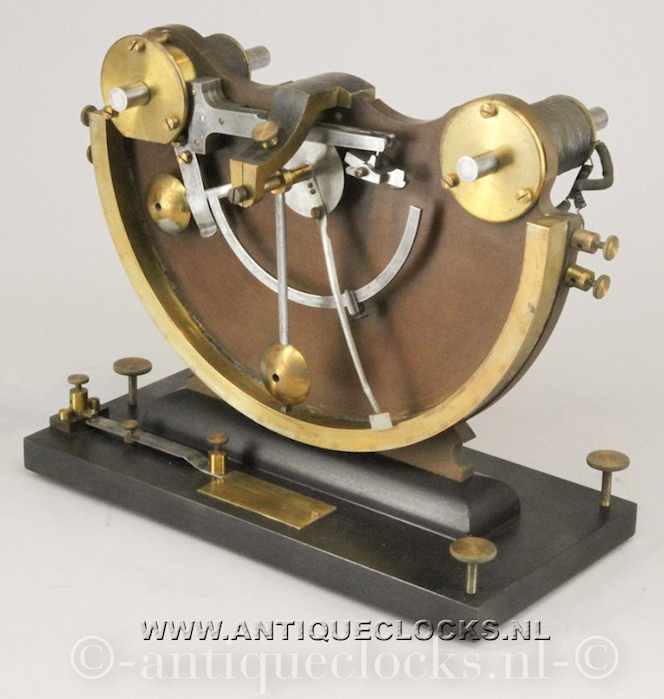You are here: Home > Firearms > British Military Longarms > Small Arms Trials
Written by: David Minshall
Ballistic Pendulum

The ballistic pendulum invented by Benjamin Robins (1707 – 1751), who is justly held to be the pioneer of modern gunnery, was first used in 1740, with the object of measuring the velocity of projectiles and the resistance of the air. It consisted of a tripod, from the top of which was suspended a pendulum, vibrating freely on its axis of suspension. The bob was a block of wood backed with iron and weighing about 56 pounds. The bullets striking this remained imbedded in it, and the pendulum on being struck absorbed their kinetic energy and swung backwards and upwards drawing out a narrow ribbon to the exact distance to which it has swung. The length of the swing gave a precise measure of the force which had actuated the pendulum; the weight of the bullet and the pendulum being known, also the radius of arc, the velocity of the striking body can thus be determined.
As the 19th Century went on the Ballistic Pendulum grew to massive sizes to cope with artillery. Around the year 1800, Professor Hutton at Woolwich was using the system for cannon with bobs weighing 2,000 pounds. A form of the pendulum was also used to measure the force of the recoil in large guns.
Navez Apparatus
Electro-ballistic apparatus was seeing use by the mid-19th Century. On such device was Navez Apparatus, which saw use in Great Britain with both small arms and artillery.
The construction of the Electro-Ballistic Apparatus by Captain Navez (Belgian Artillery), dates back to the year 1849. The apparatus itself is an arrangement for measuring, with extreme accuracy, a certain very small interval of time. Two screens, the nearer one a short space from the muzzle of the gun, are placed at an accurately measured distance apart, and it is the object of the instrument to ascertain the time which the projectile takes to pass over the measured space.

The instrument consists essentially of a pendulum freely suspended in front of a graduated arc, and an electro-magnet to hold the pendulum in position at the zero point. The current for the magnet passes through the first screen. The current which passes through the second screen holds, by means of an electro magnet, a weight suspended over a spring, a point from which is kept just over a cup of mercury. When this weight is permitted to fall, it presses the point into the cup of mercury, and completes the circuit, magnetizing the horseshoe magnet which clamps the vernier needle.
When the projectile cuts the wires in the first screen, the magnet which holds the bob of the pendulum in its initial position is demagnetized, and the pendulum commences an oscillation. When the wires in the second screen are cut, the weight drops and completes the circuit, clamping the vernier, and the arc through which the pendulum has moved is a datum from which may be computed the corresponding time.
From this reading has to be deducted the time taken for the weight to fall. This is achieved by breaking the two currents simultaneously and recording the reading of the needle. With the difference between this and the first determined, the arc corresponding to the time of flight of the projectile between the targets is found, and from which the velocity can be calculated.
Reference
- Benet, Bvt. Lt.-Col. S.V., Electro-Ballistic Machines (D.Van Nostrand, New York, 1866)
- Curtis, W.S., Benjamin Robins (1707-1751): The father of Modern Ballistics (Classic Arms, March/April 1998)
- Noble, Captain, late Royal Artillery, Report on Experiments with Navez’s Electro-Ballistic Apparatus (The Royal Artillery Institution, 1863)
- Antique scientific military artillery instrument, Chronoscope by Navez-Leurs. nr. 111, courtesy of Antique Clocks, Watches & Barometers